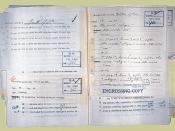Most legislative proposals are in the form of bills and are designated as H.R. (House of Representatives) or S. (Senate), depending on the House in which they originate, and are numbered consecutively in the order in which they are introduced during each Congress. Public bills deal with general questions and become Public Laws, or Acts, if approved by Congress and signed by the President. Private bills deal with individual matters such as claims against the Federal Government, immigration and naturalization cases, land titles, et cetera, and become private laws if approved and signed. Any Member in the House of Representatives may introduce a bill at any time while the House is in session by simply placing it in the "hopper" provided for the purpose at the side of the Clerk's desk in the House Chamber. The sponsor's signature must appear on the bill. A public bill may have an unlimited number of co-sponsoring Members.
The bill is assigned its legislative number by the Clerk and referred to the appropriate committee by the Speaker, with the assistance of the Parliamentarian. The bill is then printed in its introduced form, word for word. The President, a member of the Cabinet or head of a Federal agency can also propose legislation but they must get a member of congress to sponsor the bill.
When a bill reaches a committee, a standing committee, it is placed on the committee's calendar. A bill can be referred to a subcommittee or considered by the committee as a whole. It is at this point that a bill is examined carefully and its chances for passage are determined. If the committee does not act on a bill, it is the equivalent of killing it. Often, bills are referred to a subcommittee for study and hearings. Hearings provide the...


